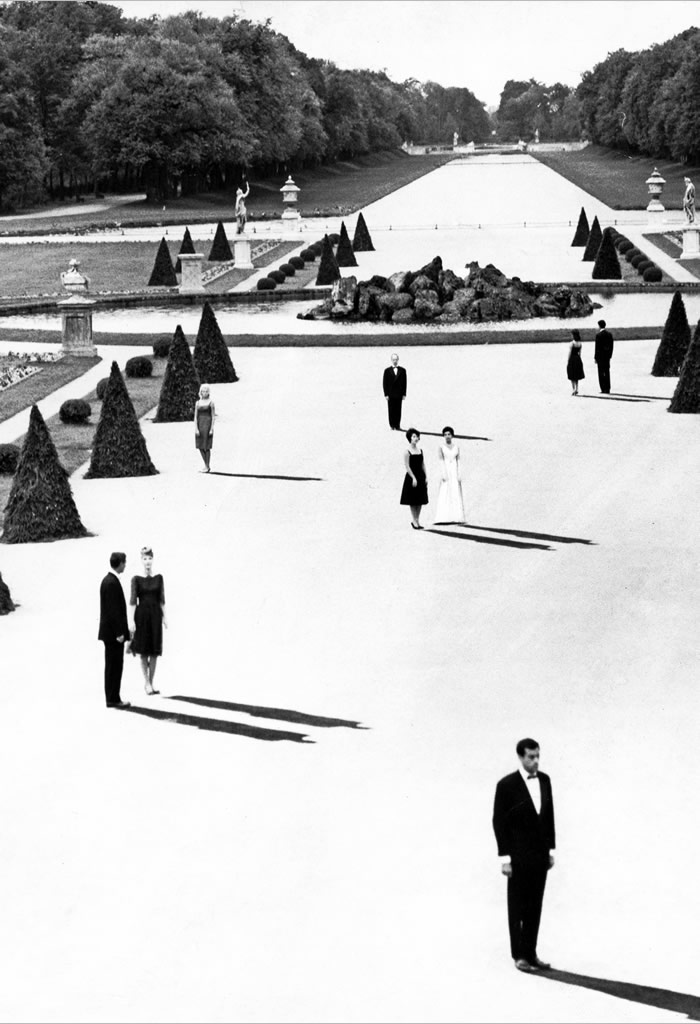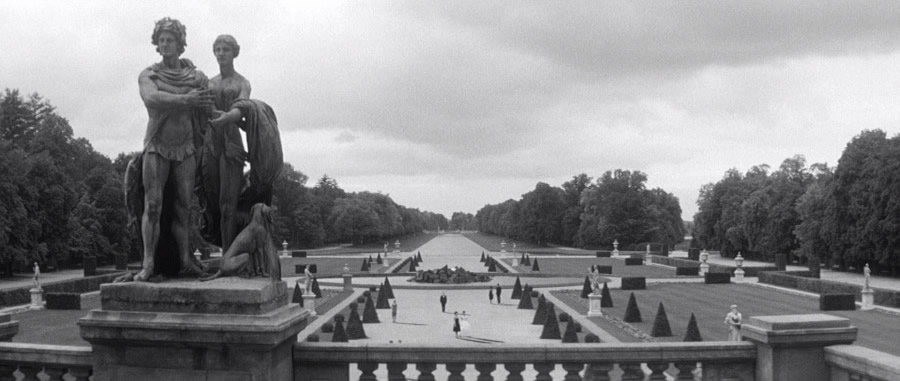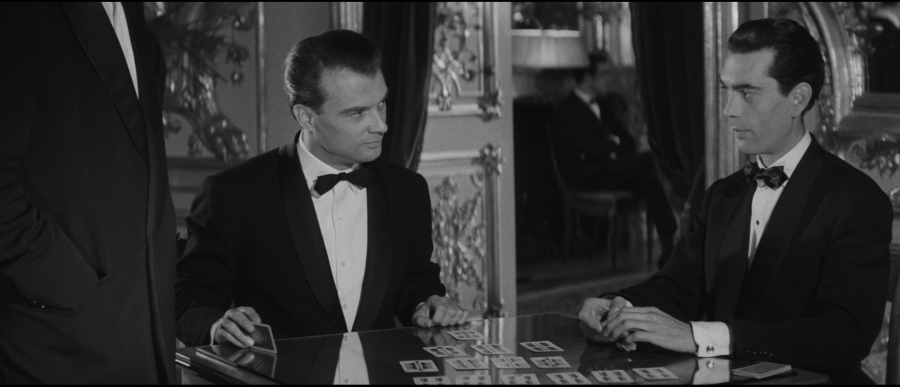Film: L'Année dernière à Marienbad

Directed by Alain Resnais from a screenplay by Alain Robbe-Grillet. Shot at Photosonore-Marlgnan-Simo Studios, Paris and on location in Munich and the chateaux Nymphenburg, Schleíssheim and Amalienburg over a period of ten weeks in autumn 1960.
Last Year at Marienbad (1961) In a baroque chateau in Bavaria, the camera pans the walls and ceilings, accompanied by eerie organ music and the voice of the unseen narrator: “Once again - I walk on, once again, down these corridor, through these halls, these galleries, in this structure - from another century, this enormous luxurious, baroque - lugubrious hotel, where endless corridors succeed silent-deserted corridors overloaded with a dim, cold ornamentation of woodwork, stucco mouldings, marbles, dark mirrors, dim paintings, columns, heavy hanging e….” These words will be repeated several times during the film, with slight variations in the order but none in tone. Gradually, the voice mingles with that of a play going on. The woman in the play waits for the clock to strike, then yields to the man, which, in microcosm, is the story of the film as well. The play also contains a balcony, a statue and geometrically rigid gardens, all of which find their counterparts in the film. The camera moves among the guests, and fragments of conversations are overheard, suggesting mysteries, little intrigues a story about someone named Franck. X meets the beautiful and statuesque A (Delphine Seyrig) and notes that she hardly seems to remember him.
He begins the memory of their first meeting in the gardens of Frederiksbad (or maybe it was elsewhere), at which time they discussed a statue in the gardens. As with the play within the film, once the statue is evoked in a “memory,” it comes repeatedly into play, actualized within the film, as though X's accounts created the physical spaces around him and A. Mixed with these “meetings” between X and A are “confrontations” between X and M, who may be A's husband or lover or guardian. X and M play games which X usually initiates and at which he usually loses: the Nim game, card games, match games, dominoes. X suggests further memories to A: a walk in the gardens and a story of a broken heel. When he suggests that he went up to her room one night, she seems horrified and drops her glass. The broken glass becomes tied figuratively with the memory of the broken heel and later with the broken balcony. Succeeding shots detail the various possibilities of A's room, from an exaggerated whiteness to a more realistic look, from elaborate ornamentation about her bed to a more simple (more realistic?) bed. X states that it is really M that A is afraid of, not the acceptance of a shared past. Gradually, A seems to accept X's verbalised past but not his invitation to go away with him.

With the possibility that A might be persuaded, X seems to lose grasp of his accounts; his tales have been of the past, of last year, toward convincing A. Their going away together points now toward the present and future, which leaves X confused and struggling between possible "endings" to the story. In one possible ending, a jealous M kills A. X rejects this, saying that he must have A alive. Another ending involves a rape, also rejected by X and visualized in the film by the repeated overexposed shots of A coming to meet X with feathered arms outstretched. After a meeting in the garden, X hurdles the balustrade of the balcony and it breaks. A screams, and her screams are identical with those of an earlier scene, the visuals returning to that earlier scene in the bar when A dropped her glass. M and A meet in her bedroom, and it is clear that M knows she will leave him, despite her protestations that he keep her. While everyone else at the chateau is attending the play that began the film, X and A leave at midnight, as they had previously agreed. The voice of X reveals that the gardens outside present a new labyrinth, a new closed world to succeed the closed world of the chateau, which, for the first time, appears well-lit, friendly and even somewhat inviting. "It seemed, at first glance, impossible to get lost here...at first glance...down straight paths, between the statues with frozen gestures and the granite slabs, where you were now already getting lost forever, in the calm night, alone with me." A has been persuaded, then, to leave one imaginary world for another.
Robbe-Grillet notes that the theme of the film is that of persuasion, that it doesn't matter whether or not they really met "last year'' at Marienbad or elsewhere (he thinks they didn't), that the only "time" in the film is the time of projection. He notes that the film could be taken, in fact, as a documentary about a statue, with all the various and contradictory interpretations given to the statue. The overall structure of the film is that of the labyrinth, in which linearity and causality are broken and by which any "restructuring" of the film's events in any order other than that given within the film is doomed to fail. The film merges several myths and legends; Death's reprieve of a year and a day to a beautiful maiden; Sleeping Beauty; Cinderella; the Arabian Nights; Orpheus and Eurydice in the underworld; Don Juan. The film also suggests the literary influence of Kafka, Borges and Bioy Casares, as well as the filmic influence of L'Herbier, Delluc, Epstein and Jean Cocteau.

Resnais and Robbe-Grillet had originally an enormous struggle just to get the film shown. Both the producers and the distributor were disenchanted with the film, thinking that the film would only confuse and frustrate spectators. Resnais and Robbe-Grillet arranged private screenings for Andre Breton, Jean-Paul Sartre and Michelangelo Antonioni, with only varying degrees of encouragement from those three as a result. Somewhat surreptitiously, Resnais and Robbe-Grillet had the film entered in the Venice Film Festival. By winning a prize at that festival, the film's survival was assured. Resnais and Robbe-Grillet had intended to show in the credits that there was no separation between director and scenarist: they would co-sign the film equally. Yet, once the script was completed, Robbe-Grillet never appeared on the set. During the shooting of the film, he was already in Turkey, shooting L'Immortelle, which he had scripted prior to writing Last Year at Marienbad.

There were ultimately several discrepancies between the shooting script and the final film. Robbe-Grillet's script called for a man much older than Pitoeff to play the part of M, and his scenes of a "realistic" rape, with exaggerated screams and theatrical gestures, were replaced by the "white angel" shots of Resnais. Robbe-Grillet notes that the continuity established by the organ music was Resnais' idea. Robbe-Grillet would have liked a sound-track of "natural" sounds (the elevator doors, the various bells) mixed with sounds of footsteps, single musical notes and human screams, all in a serial arrangement. Finally, they disagreed on the basic premise of the film: Resnais still believes that X and A had met previously, while Robbe-Grillet contends that any meeting between them can only take place in the present-tense of the film itself.
